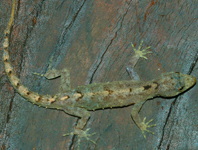Abstract
Pseudopsinae represented by four genera with just over 50 species in the Recent fauna represent one of the smallest subfamilies of the megadiverse family Staphylinidae. Here we describe the first fossil member of the subfamily Pseudopsinae. Cretopseudopsis maweii gen. et sp. nov. preserved in mid-Cretaceous Burmese amber (ca. 99 Ma) is distinguished from extant pseudopsine genera by head not carinate, apical maxillary palpomere only slightly narrower than penultimate segment, subocular carinae absent, temples short, pronotal lateral margin smoothly rounded, and mesocoxae separated by an elongate process of the mesoventrite. Our discovery of Cretopseudopsis gen. et sp. nov. provides evidence that the subfamily Pseudopsinae originated by the Albian–Cenomanian and suggests a Gondwanan distribution of the group in the Cretaceous.
References
Cai, C., Escalona, H.E., Li, L., Yin, Z., Huang, D. & Engel, M.S. (2018) Beetle pollination of cycads in the Mesozoic. Current Biology, 28, 2806–2812.
https://doi.org/10.1016/j.cub.2018.06.036
Cong, S. & Ashworth, A.C. (1996) Palaeoenvironmental interpretation of Middle and Late Wisconsinan fossil coleopteran assemblages from western Olympic Peninsula, Washington, USA. Journal of Quaternary Science, 11 (5), 345–356.
https://doi.org/10.1002/(SICI)1099-1417(199609/10)11:5%3C345::AID-JQS259%3E3.0.CO;2-A
Cruickshank, R.D. & Ko, K. (2003) Geology of an amber locality in the Hukawng Valley, northern Myanmar. Journal of Asian Earth Sciences, 21 (5), 441–455.
https://doi.org/10.1016/S1367-9120(02)00044-5
Gimmel, M. L., Szawaryn, K., Cai, C. & Leschen, R. A. (2019) Mesozoic sooty mould beetles as living relicts in New Zealand. Proceedings of the Royal Society B, 286 (1917), 20192176.
https://doi.org/10.1098/rspb.2019.2176
Grebennikov, V.V. (2005) Older-instar larvae of Pseudopsinae (Coleoptera: Staphylinidae): morphological description of three genera and phylogenetic placement of the subfamily. European Journal of Entomology, 102, 713–724.
https://doi.org/10.14411/eje.2005.102
Green, C.P., Branch, N.P., Russell Coope, G., Field, M.H., Keen, D.H., Wells, J.M., Schwenninger, J.-L., Preece, R.C., Schreve, D.C., Canti, M.G. & Gleed-Owen, C.P. (2006) Marine isotope stage 9 environments of fluvial deposits at Hackney, north London, UK. Quaternary Science Reviews, 25, 89–113.
https://doi.org/10.1016/j.quascirev.2004.10.011
Herman, L.H. (1977) Revision and phylogeny of Zalobius, Asemobius, and Nanobius, new genus (Coleoptera, Staphylinidae, Piestinae). Bulletin of the American Museum of Natural History, 159 (2), 45–86.
Herman, L.H. (1986) Revision of Bledius. Part IV. Classification of species groups, phylogeny, natural history, and catalogue (Coleoptera, Staphylinidae, Oxytelinae). Bulletin of the American Museum of Natural History, 184 (1), 1–367.
Herman, L.H. (2001) Catalog of the Staphylinidae (Insecta: Coleoptera). 1758 to the end of the second millennium. IV. Staphylinine group (Part 1) Euaesthetinae, Leptotyphlinae, Megalopsidiinae, Oxyporinae, Pseudopsinae, Solieriinae, Steninae. Bulletin of the American Museum of Natural History, 265, 1807–2440.
https://doi.org/10.1206/0003-0090.265.1.4
Kasule, F.K. (1970) The larvae of Paederinae and Staphylininae (Coleoptera: Staphylinidae) with keys to the known British genera. Transactions of the Royal Entomological Society of London, 122, 49–80.
https://doi.org/10.1111/j.1365-2311.1970.tb00527.x
Mao, Y.Y., Liang, K., Su, Y.T., Li, J.G., Rao, X., Zhang, H., Xia, F.Y., Fu, Y.Z., Cai, C.Y. & Huang, D.Y. (2018) Various amberground marine animals on Burmese amber with discussions on its age. Palaeoentomology, 1 (1), 91–103.
https://doi.org/10.11646/palaeoentomology.1.1.11
McKenna, D.D., Farrell, B.D., Caterino, M.S., Farnum, C.W., Hawks, D.C., Maddison, D.R., Seago, A.E., Short, A.E.Z., Newton, A.F. & Thayer, M.K. (2015) Phylogeny and evolution of Staphyliniformia and Scarabaeiformia: forest litter as a stepping stone for diversification of nonphytophagous beetles. Systematic Entomology, 40, 35–60.
https://doi.org/10.1111/syen.12093
Metcalfe, I. (1998) Palaeozoic and Mesozoic geological evolution of the SE Asia region: multidisciplinary constraints and implications for biogeography. In: Hall, R. & Holloway, J.D. (Eds.), Biogeography and Geology of SE Asia. Backhuys, Leiden, pp. 25–41.
Newton, A.F. (1982) Re-definition, revised phylogeny and relationships of Pseudopsinae (Coleoptera: Staphylinidae). American Museum Novitates, 2743, 1–13.
Newton, A.F. (1990) Insecta: Coleoptera: Staphylinidae adults and larvae. In: Dindal, D.L. (Ed.), Soil Biology Guide. John Wiley & Sons, New York, pp. 1137–1174.
Newton, A.F. & Thayer, M.K. (2003) Catalog of higher taxa of Staphyliniformia and genera and subgenera of Staphylinoidea, Field Museum of Natural History, Chicago. Available from: http://www.fieldmuseum.org/peet_staph/db_1a.html (accessed 9 November 2020)
Poinar Jr., G. (2018) Burmese amber: evidence of Gondwanan origin and Cretaceous dispersion. Historical Biology, 31 (10), 1304–1309.
https://doi.org/10.1080/08912963.2018.1446531
Scudder, S.H. (1900) Adephagous and clavicorn Coleoptera from the Tertiary deposits at Florissant, Colorado, with descriptions of a few other forms and a systematic list of the nonrhynchophorous Tertiary Coleoptera of North America. Monographs of the United States Geological Survey, 40, 1–148.
https://doi.org/10.5962/bhl.title.965
Shi, G.H., Grimaldi, D.A., Harlow, G.E., Wang, J., Wang, J., Yang, M.C., Lei, W.Y., Li, Q.L. & Li, X.H. (2012) Age constraint on Burmese amber based on U-Pb dating of zircons. Cretaceous Research, 37, 155–163.
https://doi.org/10.1016/j.cretres.2012.03.014
Thayer, M.K. (2016) Staphylinidae. In: Beutel, R.G. & Leschen, R.A.B. (Eds.), Handbook of Zoology. Vol. IV. Part 38. 2nd Edition. Coleoptera. Vol. 1. Morphology and Systematics (Archostemata, Adephaga, Myxophaga, Staphyliniformia, Scarabaeiformia, Elateriformia). De Gruyter, Berlin, pp. 394–442.
Westerweel, J., Roperch, P., Licht, A., Dupont-Nivet, G., Win, Z., Poblete, F., Ruffet, G., Swe, H.H., Thi, M.K. & Aung, D.W. (2019) Burma Terrane part of the Trans-Tethyan arc during collision with India according to palaeomagnetic data. Nature Geoscience, 12, 863–868.
https://doi.org/10.1038/s41561-019-0443-2


